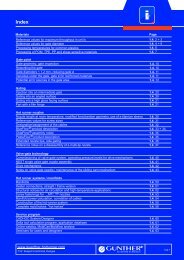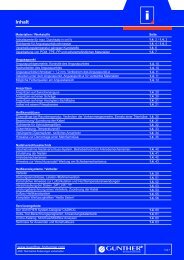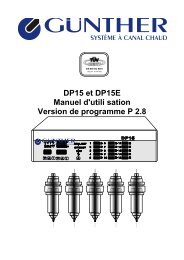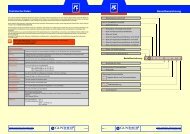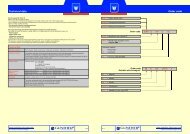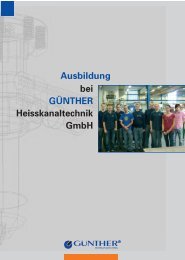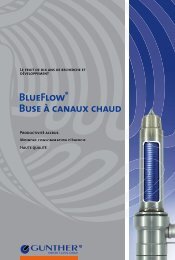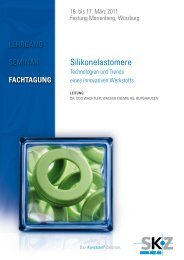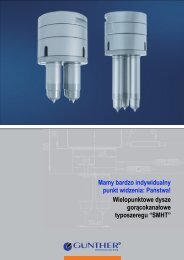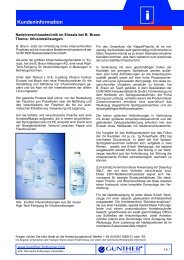Heißkanaldüsen Typ SLT/-DLT Customer information
Heißkanaldüsen Typ SLT/-DLT Customer information
Heißkanaldüsen Typ SLT/-DLT Customer information
Create successful ePaper yourself
Turn your PDF publications into a flip-book with our unique Google optimized e-Paper software.
1.5. 27<br />
iA<br />
<strong>Heißkanaldüsen</strong> <strong>Typ</strong> <strong>SLT</strong>/-<strong>DLT</strong> <strong>Customer</strong> <strong>information</strong><br />
Precision and costs under control<br />
Another aspect has been observed in practice: thanks to<br />
the fast heating and stable temperatures in the nozzles -<br />
nozzle temperature and setpoints are now at the same<br />
level for all eight nozzles -, the mould can be started up<br />
without any problem. Restarting after a fault is also easy<br />
now too. This also contributes greatly to reducing costs<br />
during the process and it increases process reliability.<br />
®<br />
Keyword: BlueFlow nozzle technology<br />
The core element in the new nozzles are the thick-film<br />
heating elements developed by Günther and a project<br />
partner. The dielectric layer and the heating conductor<br />
paths are applied to a stainless steel casing in screen<br />
printing under clean room conditions and burnt in<br />
afterwards. A covering layer insulates and protects the<br />
heating element from external influences. The most<br />
important advantage of the thick-film heater: the heating<br />
traces can be brought closer to the material, allowing a<br />
much more precise output distribution over the entire<br />
heating tube because<br />
the conductor paths can be varied in terms of width (and<br />
output) and positioning. This makes it easier than before<br />
to achieve a high concentration of power in the front<br />
nozzle area, for example.<br />
The entire heating element, is only about 1.00 mm.<br />
Compared to conventional brass heating elements, the<br />
new thick- film heaters are therefore much finer and have<br />
a narrower diameter. Other outstanding features in the<br />
heating elements are the high dielectric strength and<br />
non-hygroscopy, which puts an end to the previously<br />
customary slow heating to 100 °C and subsequent<br />
interruption in heating to drive water vapour out of the<br />
hot-runner systems.<br />
The bottom line ®<br />
The BlueFlow technology is fundamentally compatible<br />
with previous nozzle systems and retrofitting is possible.<br />
The slight increase in investment costs must be viewed<br />
against the direct savings and increased reliability in<br />
Weißer+Grießhaber applications:<br />
The bottom line<br />
The BlueFlow® technology is fundamentally compatible<br />
with previous nozzle systems and retrofitting is possible.<br />
The slight increase in investment costs must be viewed<br />
against the direct savings and increased reliability in<br />
Weißer+Grießhaber applications:<br />
• Less downtime due to the faster and problem-free<br />
start-up, even after faults.<br />
• Energy consumption is reduced by about to 30 per<br />
cent because the temperature is lower.<br />
• Significantly less rejects due to the improved temperature<br />
control in the nozzles, reduced process temperature<br />
and lower pressure levels. The lower pressure<br />
allows the use of a smaller injection moulding machine<br />
as an alternative, which further reduces costs.<br />
• Stable process with lower downtimes and accordingly<br />
a higher output.<br />
• Heat loss is reduced, not only by the smaller outer<br />
contours of the nozzles but also by the low heat<br />
conductivity of the two-part nozzle shaft (patent: DE<br />
412 70 36 issued on 4 May 1995) with ist combination<br />
of materials, steel in the back and a titanium alloy in<br />
the front.<br />
In addition, the new heating technology benefits from<br />
other features in the redesigned mould, such as the<br />
narrower diameter compared to that of conventional<br />
systems. This allows smaller nest spacing and<br />
accordingly smaller moulds or a greater number of<br />
cavities with the corresponding improved efficiency and<br />
yield.<br />
“A precise calculation of the cost per piece is not<br />
available for this application yet. However, the pay-off<br />
became evident in less than half a year”, said Siegfried<br />
Kaiser.<br />
Fig. Precision times eight – the newly-designed Günther hot-runner<br />
nozzles reduce process temperature and the required pressure,<br />
which is also gentle on the material.<br />
GÜNTHER Heisskanaltechnik GmbH<br />
Dr. Frédèric Zimmermann<br />
For any questions, please contact our Application Engineering department at + 49 (0) 6451 5008-31 or -63.<br />
The <strong>information</strong> is given in accordance with our present-day knowledge and is meant to provide technical background.<br />
www.guenther-hotrunner.com<br />
Subject to technical changes 7/12



